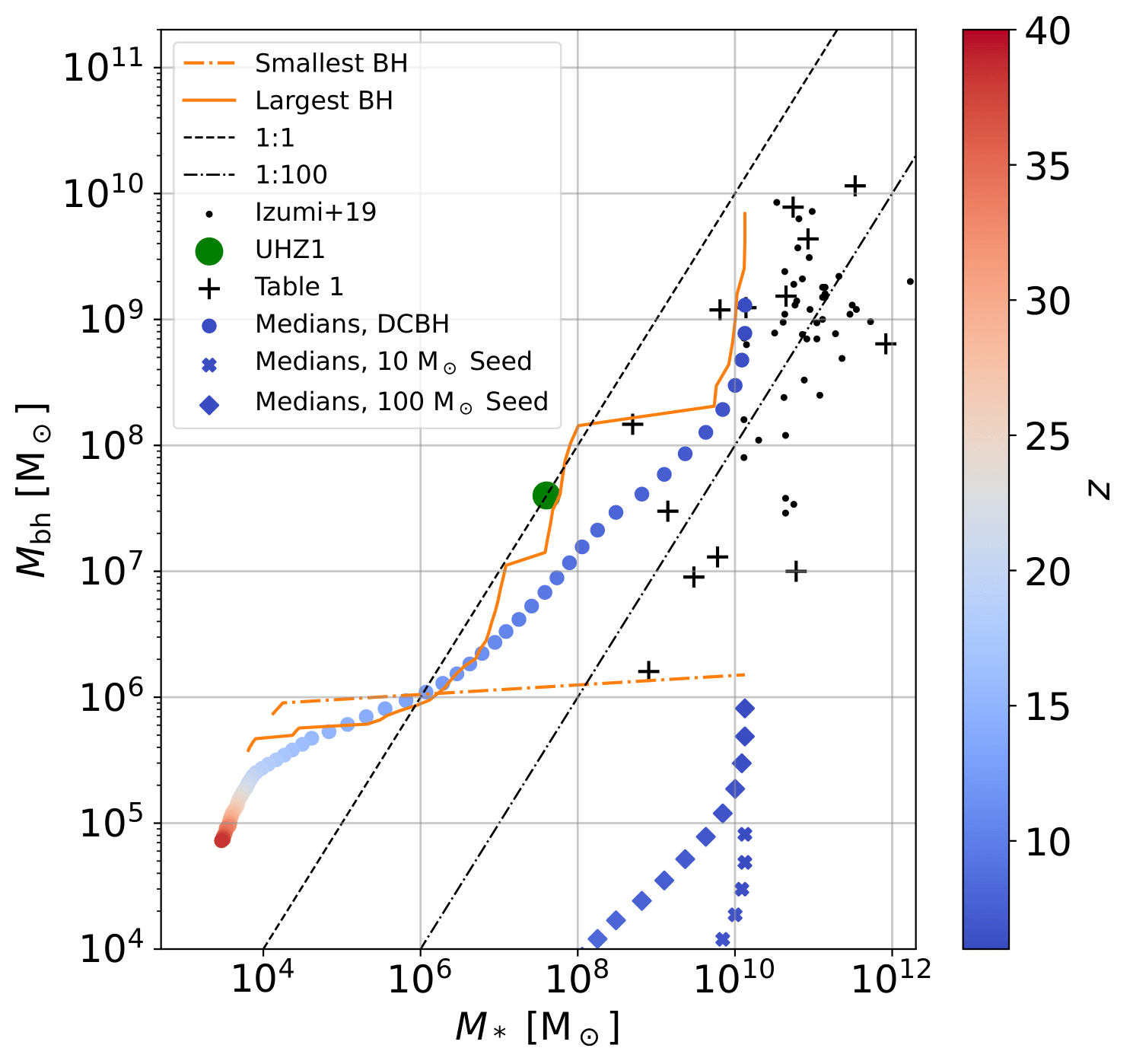There are over 200 detections of supermassive black holes (SMBHs), each billions of times more massive than our Sun. These objects were in place in the first billion years of the universe, making them too large to be accounted for by known black hole formation mechanisms and limits on black hole growth. We explore the "direct-collapse" formation mechanism for these SMBHs, where a cloud collapses into a supermassive star and forms a 'heavy seed' ~10,000 solar mass black hole. This jump start in mass allows these objects to grow so large so early in our Universe.
These heavy seeds have a unique feature, where the black hole mass is much larger than the total nearby stellar mass. In our first project, we explore how long this mass relation holds for two candidate direct-collapse sites. In the second, we do a similar exploration for 10,000 DCBH sites using Monte-Carlo merger trees. We find that this relation lasts long enough to be detected by James Webb and X-ray observations.
Abstract 1: The existence of 109 M⊙ supermassive black holes (SMBHs) within the first billion years of the Universe remains a puzzle in our conventional understanding of black hole formation and growth. Several suggested formation pathways for these SMBHs lead to a heavy seed, with an initial black hole mass of 104-106 M⊙. This can lead to an overly massive BH galaxy (OMBG), whose nuclear black hole's mass is comparable to or even greater than the surrounding stellar mass: the black hole to stellar mass ratio is Mbh/M*>10-3, well in excess of the typical values at lower redshift. We investigate how long these newborn BHs remain outliers in the Mbh-M* relation, by exploring the subsequent evolution of two OMBGs previously identified in the Renaissance simulations. We find that both OMBGs have Mbh/M* > 1 during their entire life, from their birth at z≈15 until they merge with much more massive haloes at z≈8. We find that the OMBGs are spatially resolvable from their more massive, 1011 M⊙, neighboring haloes until their mergers are complete at z≈8. This affords a window for future observations with JWST and sensitive X-ray telescopes to diagnose the heavy-seed scenario, by detecting similar OMBGs and establishing their uniquely high black hole-to-stellar mass ratio.
Abstract 2: Supermassive black holes (SMBHs) with masses of ∼109 M⊙ within the first billion year of the universe challenge our conventional understanding of black hole formation and growth. One pathway to these SMBHs proposes that supermassive stars (SMSs) born in pristine atomic cooling haloes (ACHs) yield massive seed BHs evolving to these early SMBHs. This scenario leads to an overly massive BH galaxy (OMBG), in which the BH to stellar mass ratio is initially Mbh/M* ≥1, well in excess of the typical values of 10-3 at low redshifts. Previously, we have investigated two massive seed BH candidates from the Renaissance simulation and found that they remain outliers on the Mbh-M* relation until the OMBG merges with a much more massive halo at z=8. In this work, we use Monte-Carlo merger trees to investigate the evolution of the Mbh-M* relation for 50,000 protogalaxies hosting massive BH seeds, across 10,000 trees that merge into a 1012 M⊙ halo at z=6. We find that up to 60% (depending on growth parameters) of these OMBGs remain strong outliers for several 100 Myr, down to redshifts detectable with JWST and with sensitive X-ray telescopes. This represents a way to diagnose the massive-seed formation pathway for early SMBHs. We expect to find ~0.1-1 of these objects per JWST NIRCam field per unit redshift at z≥6. Recently detected SMBHs with masses of ∼107 M⊙ and low inferred stellar-mass hosts may be examples of this population.


